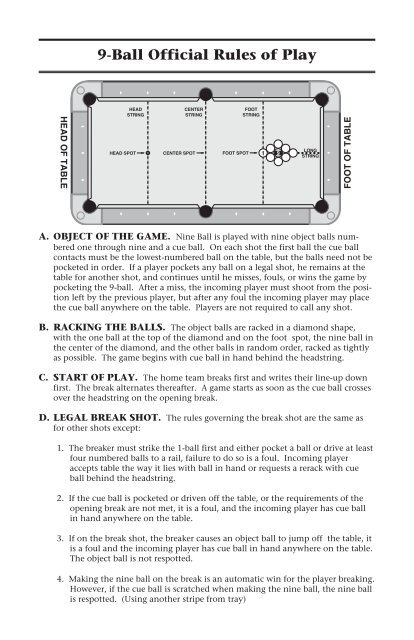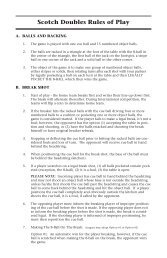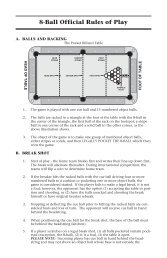You also want an ePaper? Increase the reach of your titles
YUMPU automatically turns print PDFs into web optimized ePapers that Google loves.
9-<strong>Ball</strong> Official <strong>Rules</strong> of Play<br />
HEAD OF TABLE<br />
HEAD<br />
STRING<br />
CENTER<br />
STRING<br />
HEAD SPOT CENTER SPOT FOOT SPOT<br />
FOOT<br />
STRING<br />
1 9<br />
LONG<br />
STRING<br />
FOOT OF TABLE<br />
A. OBJECT OF THE GAME. Nine <strong>Ball</strong> is played with nine object balls numbered<br />
one through nine and a cue ball. On each shot the first ball the cue ball<br />
contacts must be the lowest-numbered ball on the table, but the balls need not be<br />
pocketed in order. If a player pockets any ball on a legal shot, he remains at the<br />
table for another shot, and continues until he misses, fouls, or wins the game by<br />
pocketing the 9-ball. After a miss, the incoming player must shoot from the position<br />
left by the previous player, but after any foul the incoming player may place<br />
the cue ball anywhere on the table. Players are not required to call any shot.<br />
B. RACKING THE BALLS. The object balls are racked in a diamond shape,<br />
with the one ball at the top of the diamond and on the foot spot, the nine ball in<br />
the center of the diamond, and the other balls in random order, racked as tightly<br />
as possible. The game begins with cue ball in hand behind the headstring.<br />
C. START OF PLAY. The home team breaks first and writes their line-up down<br />
first. The break alternates thereafter. A game starts as soon as the cue ball crosses<br />
over the headstring on the opening break.<br />
D. LEGAL BREAK SHOT. The rules governing the break shot are the same as<br />
for other shots except:<br />
1. The breaker must strike the 1-ball first and either pocket a ball or drive at least<br />
four numbered balls to a rail, failure to do so is a foul. Incoming player<br />
accepts table the way it lies with ball in hand or requests a rerack with cue<br />
ball behind the headstring.<br />
2. If the cue ball is pocketed or driven off the table, or the requirements of the<br />
opening break are not met, it is a foul, and the incoming player has cue ball<br />
in hand anywhere on the table.<br />
3. If on the break shot, the breaker causes an object ball to jump off the table, it<br />
is a foul and the incoming player has cue ball in hand anywhere on the table.<br />
The object ball is not respotted.<br />
4. Making the nine ball on the break is an automatic win for the player breaking.<br />
However, if the cue ball is scratched when making the nine ball, the nine ball<br />
is respotted. (Using another stripe from tray)
<strong>VNEA</strong> <strong>Rules</strong> and Scoring<br />
E. CONTINUING PLAY. On the shot immediately following a legal break,the<br />
shooter may play a “push out.” If the breaker pockets one or more balls on a<br />
legal break, he continues to shoot until he misses, fouls, or wins the game. If the<br />
player misses or fouls, the other player begins his turn and shoots until he misses,<br />
fouls, or wins. The game ends when the nine ball is pocketed on a legal shot.<br />
F. PUSH OUT. The player who shoots the shot immediately after a legal break<br />
may play a push out in an attempt to move the cue ball into a better position for<br />
the option that follows. On a push out, the cue ball is not required to contact any<br />
object ball nor any rail, but all other foul rules still apply. The player must<br />
announce his intention of playing a push out before the shot, or the shot is considered<br />
to be a normal shot. Any ball pocketed on a push out does not count and<br />
remains pocketed, except for the nine ball. Following a legal push out, the incoming<br />
player is permitted to shoot from that position or to pass the shot back to the<br />
player who pushed out. A push out is not considered to be a foul as long as no<br />
rule is violated. An illegal push out is penalized according to the type of foul<br />
committed.<br />
G. FOULS. When a player commits a foul, he must relinquish his run at the table<br />
and no balls pocketed on the foul shot are spotted, except the nine ball. The<br />
incoming player is awarded ball in hand; prior to his first shot he may place the<br />
cue ball anywhere on the table. If a player commits several fouls on one shot,<br />
they are counted as only one foul.<br />
1. All fouls must be called and acknowledged before the next shot is taken.<br />
2. Touching or moving the cue ball is a foul.<br />
3. Coaching is a foul.<br />
4. Shooting the cue ball into a pocket or off the table is a foul.<br />
5. If the first object ball contacted by the cue ball is not the lowest numbered ball<br />
on the table, the shot is a foul.<br />
6. If no object ball is pocketed, failure to drive the cue ball or some object ball to<br />
a rail after the cue ball contacts the object ball is a foul.<br />
7. Pocketing the nine ball and the cue ball with the same stroke is a foul.<br />
8. Shooting without at least one foot on the floor is a foul.<br />
9. An unpocketed ball is considered to be driven off the table if it comes to rest<br />
other than on the bed of the table. It is a foul to drive an object ball off the<br />
table. The jumped object ball(s) is not spotted and play continues.<br />
When the cue ball is in hand, the player may place the cue ball any where on the<br />
bed of the table, except in contact with an object ball. He may continue to adjust<br />
the position of the cue ball until he takes a shot.<br />
H. THREE CONSECUTIVE FOULS. If a player fouls three consecutive times<br />
on three successive shots without making an intervening legal shot, he loses the<br />
game. The three fouls must occur in one game. The warning must be given<br />
between the second and third fouls. This rule is optional for local league and<br />
tournament play. (This rule will not be used at the International Championships.)<br />
A player’s turn begins when it is legal for him to take a shot and ends at the end<br />
of a shot on which he misses, fouls or wins, or when he fouls between shots.<br />
When there are only two object balls on the table and a player scratches while<br />
pocketing the ball before the nine - it shall be brought up and placed on the<br />
footspot. (Using another ball from the tray.)
<strong>VNEA</strong> <strong>Rules</strong> and Scoring<br />
I. END OF GAME. The game ends at the end of a legal shot which pockets the<br />
9-ball; or when a player forfeits the game as the result of a foul.






